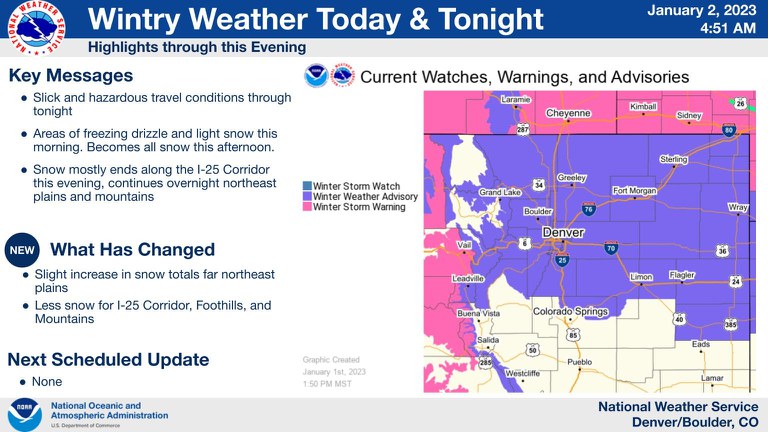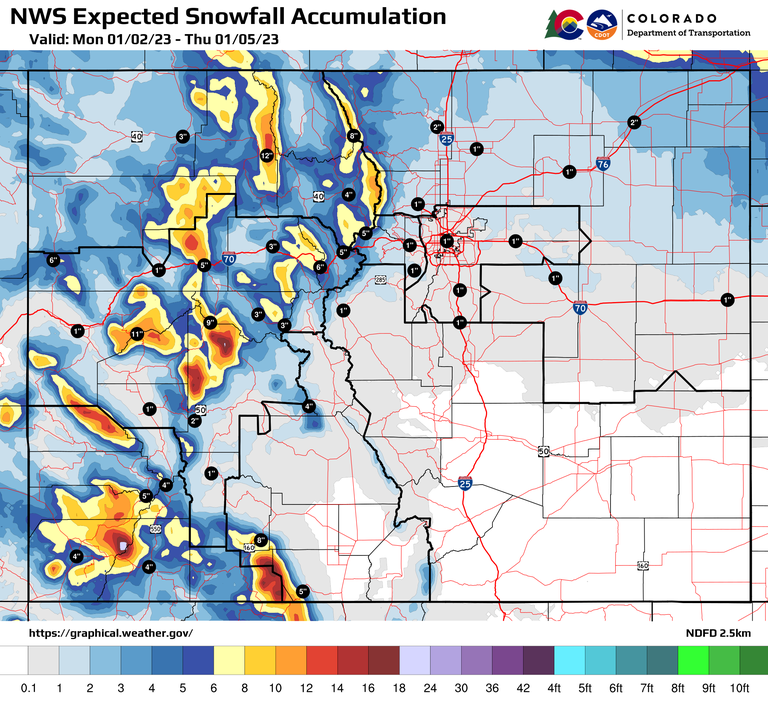Hazardous driving conditions in the mountains and along the Front Range today
Travel Advisory
Statewide - Snow continues through tonight in the mountains causing adverse driving conditions. When returning home from the mountains today, if possible, motorists should delay their travel until mid-day when impacts are not at their worst. If drivers are out, take it slow. Snow is spreading eastward along the foothills, the northern I-25 corridor and northeastern plains. Motorists are urged to be prepared for slick road conditions, including the Denver metro region and along the Front Range. Motorists should watch for possible freezing drizzle and be prepared for icy conditions on curves, shaded sections of roadways, off-ramps, flyovers and bridges. There could be possible safety closures along mountain corridors, depending on how severe the weather gets.
Due to avalanche dangers in the high country particularly in western Colorado, some mountain passes and corridors are closed, including US 550 north of Durango, US 160 Wolf Creek Pass east of Pagosa Springs, CO 133 McClure Pass and CO 139 Douglas Pass.
Travelers should be aware that additional safety closures may be implemented on many Colorado mountain highways over the next few days. Visit COtrip.org for the latest information on road closures and conditions.

CDOT crews have been in full snow shift for much of the state. Their focus is plowing the most heavily traveled state maintained routes first such as the interstates and major U.S. and state routes before moving to the secondary routes. Localities and responsible for plowing neighborhood and city streets.
What motorists should know:
- Delay or limit travel if possible during a snowstorm
- Be aware of weather and travel conditions before heading out. COtrip.org is your best source for road condition information
- You must have tires appropriate for winter weather, with a tread of at least 3/16th of an inch
- Be prepared for possible safety closures, especially in the high country - have an emergency kit to include blankets, food, batteries, a flash light and other essential supplies
- Take it slow, leave plenty of following distance and don’t pass plows
If you encounter an avalanche while in your vehicle, there are several precautions you can take to help keep you safe:
- Stay in your vehicle and keep the windows rolled up
- Turn off your vehicle to prevent carbon monoxide filling the car
- Call for help on a cell phone
- Plan ahead during the winter season and keep additional food, water, warm clothes and blankets in your vehicle
During a Passenger Vehicle Traction Law, all motorists are required to have one of the following:
- A 4WD or AWD vehicle and 3/16” tread depth
- Tires with a mud and snow designation (M+S icon) and 3/16” tread depth
- Winter tires (mountain-snowflake icon) and 3/16” tread depth
- Tires with an all-weather rating by the manufacturer and 3/16” tread depth
- Chains or an approved alternative traction device
For the most up-to-date winter driving resources, information and tips, visit winter.codot.gov.

Know Before You Go
Travelers are urged to “know before you go.” Gather information about weather forecasts and anticipated travel impacts and current road conditions prior to hitting the road. CDOT resources include:
- Road conditions and travel information: COtrip.org
- Download the COtrip Planner app: bit.ly/COtripapp
- Sign up for project or travel alerts: bit.ly/COnewsalerts
- See scheduled construction lane closures: bit.ly/laneclosures
- Connect with @ColoradoDOT on social media: Twitter, Facebook, Instagram and YouTube
Remember: Slow For The Cone Zone
The following tips are to help you stay safe while traveling through maintenance and construction work zones.
- Do not speed in work zones. Obey the posted speed limits.
- Stay Alert! Expect the unexpected.
- Watch for workers. Drive with caution.
- Don't change lanes unnecessarily.
- Avoid using mobile devices such as phones while driving in work zones.
- Turn on headlights so that workers and other drivers can see you.
- Be especially alert at night while driving in work zones.
- Expect delays, especially during peak travel times.
- Allow ample space between you and the car in front of you.
- Anticipate lane shifts and merge when directed to do so.
- Be patient!
Download the COtrip App!
The new FREE COtrip Planner mobile app was designed to meet the growing trend of information on mobile and tablet devices for the traveling public. The COtrip Planner app provides statewide, real-time traffic information, and works on mobile devices that operate on the iOS and Android platforms. Visit the Google Play Store (Android devices) or the Apple Store (iOS devices) to download!
